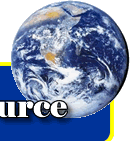 |
 |
 |
 |
||||||||||
 |
|||||||||||||
 |
|||||||||||||
 |
 |
 |
 |
 |
 |
 |
 |
 |
|||||
|
|||||||||||||||||||||||||||||||||||||||||||||||||||||||||||
|
|
5th Grade Lesson The solar system Background - The solar system comprises nine planets,
in the following order from the Sun: Mercury, Venus, Earth, Mars, Jupiter,
Saturn, Uranus, Neptune, and Pluto. Most of the planets have moons in
orbit about them, but only Earth's moon is visible to the unaided eye.
Asteroids and comets are small bodies, most of which are in irregular
orbits about the Sun. Many science texts and Web sites provide information
and photographs of objects in the solar system that are collected from
NASA’s planetary, comet, and asteroid missions and from the use
of Earth and space telescopes. Vocabulary
Lesson Our Solar System is made up of objects that circle around our sun; planets, moons, asteroids and comets. In this lesson you will become more familiar with these objects and their orbits.
Activity - Make a scale model Review - Review this lesson here Extend - Do you think there are other solar systems around other stars? Create your own solar system. Choose and name a star, several planets and moons and other objects.
|
|